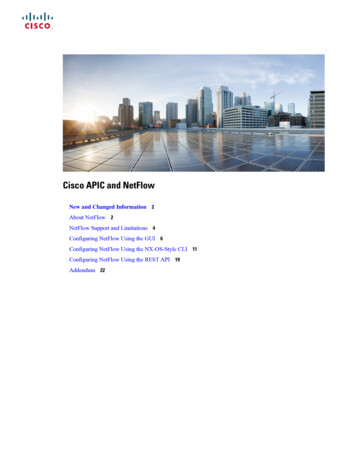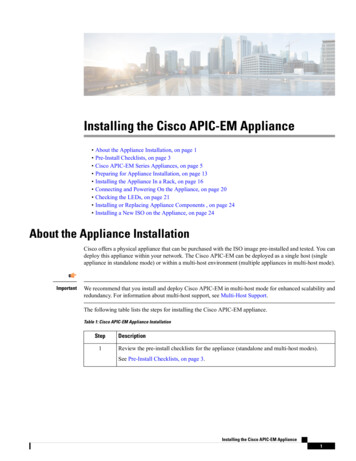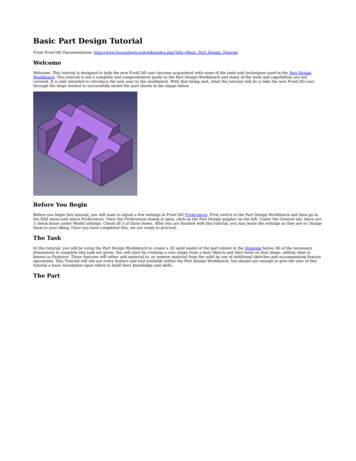
Transcription
1275 K Street, NW, Suite 1000Washington, DC 20005-4006Phone: 202/789-1890Fax: 202/789-1899apicinfo@apic.orgwww.apic.orgJune 24, 2013Ms. Marilyn TavennerAdministratorCenters for Medicare & Medicaid ServicesU.S. Department of Health and Human ServicesRoom 445-GHubert H. Humphrey Building200 Independence Avenue, SWWashington, DC 20201Re: CMS-1599-P: Medicare Program; Hospital Inpatient Prospective Payment System for Acute CareHospitals and the Long-Term Care Hospital Prospective Payment System for FY 2014Dear Ms. Tavenner:The Association for Professionals in Infection Control and Epidemiology (APIC) wishes to thank theCenters for Medicare & Medicaid Services (CMS) for the opportunity to provide input into its proposedFY 2014 Hospital Inpatient Prospective Payment System (IPPS) changes. APIC is a nonprofit, multidisciplinary organization whose mission is to create a safer world through prevention of infection. Weare pleased that CMS continues to demonstrate its commitment to improving the quality of patient careand we believe CMS is moving in the right direction. Our comments address issues raised by CMS relatedspecifically to healthcare-associated infections (HAIs).Hospital Readmissions Reduction Program-Fiscal Years 2014 and 2015APIC notes the readmission reduction measures are intended to capture unplanned readmissions thatarise from acute clinical events requiring urgent hospitalization within 30 days of discharge. Thepopulation of focus for these measures should be on those readmissions which are unplanned (i.e. fortreatment due to a complication), as planned readmissions do not necessarily signal poor quality of care.While APIC supports the addition of total hip arthroplasty (THA) and total knee arthroplasty (TKA) to thereadmission measure, we do not want to see facilities unfairly penalized if the readmission was aplanned part of the care process. Therefore, APIC supports CMS’s attempt to develop an algorithm toidentify those planned readmissions and exclude them from the measures.
Recommendation: We understand that CMS is in the process of developing an algorithm toexclude planned readmissions from the hospital readmission reduction measures. APIC supportsthis effort.Hospital Value-Based Purchasing (VBP) Program -- Fiscal Year 2016CMS identifies in the proposed rule that it intends to remove PN-3b: Blood Cultures Performed in theEmergency Department Prior to Initial Antibiotic Received in Hospital from the FY 2016 Hospital VBPProgram in part because the measure is no longer endorsed by the National Quality Forum (NQF), wasnot recommended for use by the Measure Applications Partnership (MAP), and due to the fact thatthere have been significant issues with documentation of the timing of blood cultures and the electronichealth record.Recommendation: APIC supports the removal of this measure.CMS is proposing to adopt several new measures into the VBP program including: Influenza Immunization (IMM-2, NQF #1659) as a chart abstracted prevention measure that assesseswhether patients over 6 months of age were screened for seasonal influenza immunization statusand were vaccinated prior to discharge if appropriate. Catheter-Associated Urinary Tract Infection (CAUTI, NQF #0138) in adult intensive care units (ICU) asa healthcare-associated infection measure reported via the National Healthcare Safety Network(NHSN). Surgical Site Infection (Colon Surgery and Abdominal Hysterectomy) (SSI, NQF #0753) as ahealthcare-associated infection measure reported via NHSN. NHSN-based Central Line-Associated Bloodstream Infection (CLABSI) measure in ICU patients in itscurrent state (was previously adopted).And for FY 2017: Methicillin-resistant Staphylococcus aureus (MRSA) bacteremia standardized infection ratio (SIR) Clostridium difficile (C. difficile) SIRAPIC supports the addition of the above measures and recognizes that all of these measures are nowNQF-endorsed. We note that while the Centers for Disease Control and Prevention (CDC) has submittedthe reliability-adjusted version of the CLABSI measure to NQF for endorsement, CMS is not proposing toadopt this version of CLABSI measurement at this time. APIC supports this approach and will commenton the reliability-adjusted SIR if proposed in future rulemaking. We also appreciate the integration ofthe VBP program with the Hospital Inpatient Quality Reporting (IQR) program and the intent to align thetwo programs. Aligning the two programs with measurements and reporting structure should allowhospitals to better incorporate this information into their quality improvement programs.
Although we support the additional measures, we express a note of caution that there may bedifferences in the definitions used in the baseline and performance periods. For example, for the FY2015 CLABSI measure there are differences in the NHSN definition for the baseline period (January –December 2011) versus the performance period (February – December 2013). Because of thedifferences in definitions, the baseline period may not be sufficient in establishing valid achievementscores for the performance period. APIC is concerned that healthcare institutions that use thisinformation to direct resources may be making decisions with deficient and unsatisfactory information.APIC notes that the baseline and performance periods for CLABSI for FY 2016 are not stated andrequests clarification.In addition, APIC identifies a significant discussion by CMS in the proposed rule on aligning the VBP, IQRand Electronic Health Record (EHR) Incentive Program with the National Quality Strategy (NQS) domainsbeginning with the FY 2017 Hospital VBP Program. Specifically, this would place the HAI measures intothe Safety domain. APIC believes this direction is appropriate for these measures at this time.Finally, CMS has proposed to adopt a Hospital VBP program extraordinary circumstance waiver processfor which hospitals could apply at the same time a waiver is sought for the Hospital IQR program. Thesewaivers would allow CMS to “waive” all applicable quality measure data from a performance period, andthus, exclude a hospital from the VBP program for a fiscal year during which the hospital hasexperienced a disaster or other extraordinary circumstance.Recommendations: APIC supports the addition of the global measure for influenza immunization, ICU CAUTI, ICUCLABSI and SSI for colon surgery and abdominal hysterectomy into the VBP Program for FY 2016. APIC supports the addition of MRSA bacteremia and C. difficile SIR for FY 2017 VBP, while urgingCMS to evaluate the timing of these additions in context with ongoing efforts to improve the riskadjustment and comparison analysis. APIC requests CMS provide additional detail on baseline and performance periods for CLABSI inFY 2016 as well as additional clarification on how it would account for differences in baselineand performance periods when the measurement definition changes. APIC supports the alignment of the VBP program with the NQS domains and specificallysupports placement of the HAI measures into the Safety domain. APIC supports the adoption of an extraordinary circumstance waiver process for the VBPprogram.Proposed Implementation of the Hospital-Acquired Condition (HAC) Reduction Program for FY 2015In identifying the general framework for the HAC Reduction Program, APIC recognizes that CMS is notrequired to address specific measure scoring methodologies in notice and comment rulemaking, yet has
done so in an effort to allow the public to understand how the measures are discussed and finalized.APIC appreciates this effort and applauds CMS for its transparency.CMS notes that it plans to use two Domains and separate out the AHRQ Patient Safety Indicators (PSI)from the CDC/NHSN measures due to several major differences in data source, collection andcalculation. In addition, APIC generally would be opposed to the use of any of the AHRQ measures thatare identified as infection indicators (such as PSI-7 central venous catheter-related bloodstreaminfection rate), as the AHRQ data captures events that occur only among Medicare fee-for-servicedischarges and is based on claims data. The CDC HAI measures capture data on both Medicare and nonMedicare patients and are chart abstracted using standardized definitions and reported quarterly.APIC agrees with the proposal to separate the two domains and agrees it would provide a more reliablescoring model. For Domain 1, APIC favors the proposed approach of using the six individual AHRQ PSIs asopposed to the alternative approach which incorporates one composite of 8 component indicators. Aswe have previously commented to CMS, composite measures lack specificity and relevance and do notallow intended audiences to focus on specific, meaningful prevention strategies. APIC applauds CMSefforts to publish data that is meaningful and can support provider efforts to impact clinical change atthe bedside. Due to this, we do not support the alternative measure set that includes AHRQ PSI-90, for itis a composite measure and it incorporates PSI-7 central venous catheter-related blood streaminfections rate, which would be reported via a different collection measure in Domain 2. Havingdifferent definitions associated with bloodstream infections (one collected via administrative data as inthe alternate approach to Domain 1 and one collected via epidemiological surveillance as in Domain 2)can cause confusion and has the potential for misdirection of finite resources.APIC appreciates CMS’s use of CDC/NHSN, rather than claims-based data for the Domain 2 measures ofCLABSI and CAUTI (FY 2015, FY 2016, FY 2017); SSI – Colon Surgery and Abdominal Hysterectomy (FY2016, FY 2017); and MRSA bacteremia and C. difficile (FY 2017).APIC also agrees with the use of the CDC/NHSN SIR for Domain 2 HAI measures; however, we cautionthat inpatient units with low volume/low device utilization can have data (SIRs) that aredisproportionately high due to low denominators. This may, in fact, be an inadvertent benefit to unitsthat have not aggressively made attempts to decrease catheter utilization days.Finally, APIC agrees that the process used to review and correct information through the existingHospital IQR program would be an acceptable format for updating performance rather than reviewingand correcting data in two different programs. APIC appreciates the effort of CMS to reduce the burdenon hospitals in this portion of the proposal.Recommendations: APIC supports separating the AHRQ and CDC measures into two separate domains.
APIC supports the proposal for Domain 1 over the alternative approach.APIC supports the use of the CDC/NHSN definitions for all measures in Domain 2; however, APICurges CMS to review the context of units that may have lower device utilization. APIC does notwant to see facilities unfairly penalized for reducing risk by the lowering number of days devicesare in place.APIC supports the use of the existing Hospital IQR process for review and correction ofinformation in the Hospital VBP program.Hospital Inpatient Quality (IQR) ProgramCMS notes that as part of its ongoing work to update and modify the display of this publicly reporteddata, it is proposing to make the individual PSI indicators that are part of the PSI-90 composite measureavailable to the public. APIC believes this display, which would include the individual display of PSI-7central venous catheter related bloodstream infection rate, could potentially be more confusing toconsumers in that this measurement differs significantly from another measure in the Hospital IQRProgram with a very similar name: the CDC/NHSN CLABSI measure. This could provide the public, andhealthcare facilities that must make decisions about finite resources, with confusing and conflictinginformation. Individual indicators are more relevant if properly determined. APIC would recommendthat CMS not display the individual composite measures to the public at this time.CMS also proposes to remove or suspend measures that were supported in previous rulemaking,specifically: Remove PN-3b: Blood Culture Performed in the Emergency Department Prior to First AntibioticReceived in the Hospital Measure (no longer NQF-endorsed) Remove IMM-1: Immunization for Pneumonia Measure (rapidly changing guidelines that are difficultto adapt and update within the system) Remove SCIP-Inf-10: Surgery patients with perioperative temperature management (measuretopped out) Continued suspension SCIP-Inf-6: Appropriate hair removal (measure topped out)APIC supports the removal and continued suspension of these measures, and also supports CMS’sstance which identifies that despite removal of the pneumonia vaccination measure, hospitals shouldcontinue to keep up with vaccination recommendations for various populations.Recommendations: APIC does not support display of the individual PSI indicators under the PSI-90 composite. APIC supports the removal or suspension of PN-3b, IMM-1, SCIP-Inf-10, and SCIP-Inf-6. APIC appreciates that CMS continues to encourage hospitals to appropriately vaccinate theirpatient populations.
Proposed Refinements to Existing Measures in the Hospital IQR ProgramIn the rule, CMS proposes to expand the CLABSI and CAUTI measures to select non-ICU locations(medical, surgical and medical/surgical wards) on or after January 1, 2014. APIC supports the expansionof these measures consistent with NQF endorsement, with several additional concerns andconsiderations: Hospitals are still in various phases of electronic health record implementation. Retrieval of thisdata electronically is still in a transitional phase, and manual retrieval could result in divertingresources from performance improvement activities that are in progress for the ICU-relatedmeasures. Finding a balance in data retrieval and being able to direct prevention andimprovement activities is absolutely necessary with the limited resources in healthcare.APIC additionally expresses significant concern over the forthcoming (early 2014) changes to theCDC/NHSN CAUTI definition in relationship to implementing expansion of these indicatorsbeyond the ICU. Measure definition changes also provide a challenge to facilities that rely onelectronic surveillance to assist in their data capture as the data system must receive theupdated requirements from CDC, update their systems and then pass these changes on to theend user. APIC is concerned that expanding the surveillance of CAUTI at the same time thedefinition changes could increase confusion and decrease the reliability of data collected. Thedata will not be comparable over time to assess the improvement or declining performance forpublic and healthcare administration determinations. APIC recommends the introduction of thenew CAUTI definitions for a time frame of at least one year prior to expansion outside of theICU.Therefore, APIC recommends that CMS consider a phased-in approach to this expansion, addingthe CLABSI measure before the CAUTI measure and expanding the CAUTI measure after CDC hasrevised its definition and has sufficient time to assess the impact of the changes.As mentioned earlier in our comments on the Hospital VBP Program, APIC also expresses concernregarding the low volume/low utilization device days in many patient locations that may result in highercomparative rates potentially masking a successful program where device utilization and timely removalof invasive devices is an organizational priority.CMS also identifies in this section of the proposed rule it plans to refine SCIP-Inf-4: Controlled 6 AMGlucose for Cardiac Surgery Patients (NQF #300), as this measure has undergone extensive changes aspart of the NQF endorsement maintenance process. While APIC supports this measure in general, wewould suggest that the terminology “corrective action to be documented for post-operative glucoseover 180mg/dl”, be changed to reflect a more clinically acceptable terminology rather than “corrective
action” (e.g. documentation of clinical attempt of glucose control) as “corrective action” may not alwaysbe achievable for some patients.Recommendations: APIC supports a phased-in approach of expansion with CLABSI and CAUTI beyond the ICUs,specifically recommending that CLABSI expansion be transitioned first, followed by CAUTI aftersurveillance definitions have been updated and implemented. APIC supports the refinement of the SCIP-Inf-4 measure, but recommends the language“corrective action” be replaced with “documentation of clinical attempt of glucose control.”Data Submission Requirements for Quality Measures That May be Voluntarily Electronically Reportedfor the FY 2016 Payment DeterminationAPIC appreciates the attempt of CMS to begin to align the quality measure reporting under the HospitalIQR and Medicare Electronic Health Record (EHR) programs. APIC supports the proposed voluntaryparticipation in electronic submission of one quarter of quality data measures, but reminds CMS thatHAIs are not part of Stage 1 or Stage 2 Meaningful Use, so many hospitals will be at variable levels ofcapability with HAI data via electronic submission. APIC also agrees with the proposal to give “PioneerDesignation” to encourage participation in the program.Proposed Modifications to the Validation Process for Chart-Abstracted Measures under the HospitalIQR ProgramCMS proposes to better align itself with NHSN definitions by replacing the requirement to note a“central venous catheter” (CVC) on its CLABSI validation template with the requirement to note a“central line”. In addition, CMS proposes to exclude from the CAUTI validation template all urinecultures with more than 2 organisms, even if they have greater than or equal to 1,000 colony-formingunits (CFUs)/ml as often these cultures would indicate contamination. APIC supports both of theseproposals as they align with current CDC/NHSN definitions.CMS also proposes to adopt a sub-regulatory process for handling details of the definition specifications.While APIC supports this proposal, we also respectfully request that CMS involve APIC, InfectionPreventionists (IPs) and CDC/NHSN experts in the discussion process. As refinement of the CDC/NHSNdefinitions continues, we can anticipate the process will require both IPs and validators to carefullymatch the cases and to learn from the process. APIC encourages dialogue and learning opportunities forall stakeholders in this validation and sub-regulatory process.Regarding the addition of MRSA bacteremia and C. difficile to the validation process, APIC agrees thatthis validation needs to be accomplished and appreciates the proposal from CMS to randomly assignhalf of the randomly selected hospitals (approximately 300 of the 600 selected) to submit templates for
CLABSI and CAUTI and the other half (the other 300 hospitals) would submit templates on MRSA and C.difficile infection (CDI) for validation. We agree this may reduce burden to hospitals and continue torespectfully request that CMS place into context the burden of data retrieval/validation work that isbeing requested as a whole for IPs throughout the country. As measures continue to expand andadditional validation becomes necessary, resource limitations could serve to focus infection controlprograms solely on data retrieval and submission, rather than on prevention and improving outcomes.APIC also appreciates and supports the proposal to reduce the number of validation records from 48 to36, as well as an exclusion for those outlier patients with a length of stay greater than 120 days.Certainly having valid and reliable data is important, and APIC is grateful that CMS recognizes the workintensity by all in the validation process for HAIs.CMS identified criteria for selecting hospitals for validation in previous rules. In this year’s rule, CMS isproposing an additional criterion that would target for validation any hospital that failed to report toNHSN at least half of actu
Jun 24, 2013 · CLABSI and SSI for colon surgery and abdominal hysterectomy into the VBP Program for FY 2016. APIC supports the addition of MRSA bacteremia and C. difficile SIR for FY 2017 VBP, while urging CMS to evaluate the timing of these additions in context with ongoing effort











